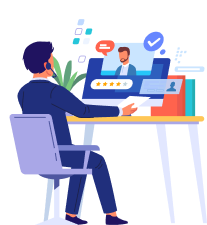
The Complete Guide to On-Page and Off-Page SEO | Digital Marketing Institute
The Complete Guide to On-Page and Off-Page SEO
- Share via:
Search Engine Optimization (SEO) has been around for almost as long as the internet has been public, and since the early days, organizations have been using it to reach new audiences, bring traffic to their websites, spread knowledge, and drive growth.
But SEO has changed a great deal since it was first used to stuff as many keywords as possible into content and fill pages with backlinks. Over time, SEO has become a sophisticated and technical practice that’s highly informed by current web user behavior, and today’s incarnation uses both on-page and off-page techniques to ensure high-quality websites make it to the top of search engine result pages.
But what exactly are on- and off-page SEO, and how can digital marketers use them to serve clients? That’s exactly what today’s discussion will be dedicated to, so stick around to learn everything you need to know about modern SEO best practices.
Understanding On-Page SEO
On-page SEO involves all the on-site techniques you can employ to ensure a webpage will rank on a SERP, and it can also help determine how well that page ranks. It uses both content and technical elements to improve the quality of a page, so the more on-page SEO you do, the more traffic you'll get to a website and the more relevant that traffic will be.
There are many different technical aspects of a webpage that can be optimized with on-page SEO, and they include:
- Title tags
- Headings
- URL structure
- Alt text for images
- Site speed
- Internal links
- Meta descriptions
- Responsiveness
On-Page SEO Technical Best Practices
Title tags are HTML elements you can use to designate the name of a webpage, and that get displayed on SERPS as the clickable result title. Each title tag should be unique, descriptive about what the page is about, optimized with a keyword and under 60 characters in length.
Headings are the titles you give your content, and these should be in H1 format for the best results. Headings should focus on relevant and descriptive words, and while you can optimize them with keywords, don’t stuff them full. In order to break up content, you can also use subheadings (H2 through H6) following the same best practices, but don’t repeat keywords or phrases throughout a post.
URL structure is important when search engines determine how relevant a page is compared to a query, and it should be descriptive of the page’s subject. You can also optimize URLs with keywords, so long as they're relevant. An example of a good URL structure would be http://www.shoelovers.com/red- suede-shoes (compared to www.shoelovers.com/123456).
Alt text or alternative text provides search engines with more information about an image, though it’s typically used to describe images to web visitors who can't see them. As such, alt text should be specific and descriptive of the image content, 125 characters or less, and optimized with a keyword or phrase only if appropriate.
Page load speed is important because slow-loading pages have high bounce rates:47 percent of people expect a site to load within two seconds, and 40 percent will leave after three. As such, search engines penalize slow-loading pages with a lower ranking, so it’s important to ensure fast page load speed.
Internal links make your site easy to navigate for visitors, but they also make it easier for search engines to understand your site and index your pages, and this will result in a higher rank. At the very least, each page on your site should link back to its category or subcategory page and to the homepage.
Meta descriptions are brief but vivid descriptions that expand on title tags, summarize a page’s content and tell web users why they should read your content instead of somebody else’s. The meta description appears below the title and the URL, and it should be kept below 160 characters.
Responsiveness is a design element that ensures your page will display properly on any device, including mobile devices and desktop ones. This will continue to be an important factor as more and more people around the world use mobile devices for online search.
Finally, a note about keywords. Keywords are the glue that holds together your on-page SEO strategy because they can be incorporated into all these technical elements to help the right visitors find you at the right time. In order to be effective, keywords must be researched and carefully selected, and they must be worked into content in a natural and seamless way.
On-Page SEO and the Impact of Content
- While the technical aspects are important, one of the most crucial elements of on-page SEO is content because this is what brings traffic to your site.
However, not just any content will do, and today’s web users are looking for relevant, interesting, engaging, and informative content that fills a need. In other words, people must want to consume the content you’ve created, which can come in a number of different forms, such as:
- Blogs
- Web page copy
- Videos
- Infographics
- Podcasts
- Whitepapers
- Ebooks
- Interviews
- Case studies
- Original research
- Reviews
- Instructional articles
- Quizzes and poles
However, another important element about the content you create is that others must be able to link to it, which means avoiding content that requires a login, copyrighted material, and certain slide shows.
Off-Page SEO and the Power of Quality Links
Just as keyword stuffing used to be an acceptable practice that’s gone the way of the dodo, so too is the practice of buying or trading spammy backlinks in an effort to increase page rank. The search engines have been wise to these practices for some time, and filling your page with irrelevant backlinks will actually get you penalized rather than promoted.
Although the search engines take into account both the number and quality of your backlinks (as well as the number of referring domains), quality is much more important than quantity.
The key takeaway is that while backlinks are integral to off-page SEO, a single quality backlink from an authoritative site is worth more than 10 or even 100 low-quality links. Link building isn't always the easiest task, but here are four strategies, according to Neil Patel, that you can use:
- Writing guest blogs to promote yourself as an expert in your field
- Write content that mentions influencers in your field, because posts like this are highly popular
- Scour blogs (particularly influencer blogs) in your field for broken links, and then suggest replacing the broken link with content you’ve written on the same subject
- Take advantage of the popularity of infographics by creating lots of them
For more insights on how to create linkable content, see our article:4 winning strategies to write content that other people link to.
Other Off-Page SEO Best Practices
Although quality backlinks are the backbone of an off-page SEO strategy, there are other techniques you can use to increase site authority and encourage more links.
One is adding your business to local listings and internet directories, including things like Google My Business, Yelp, Yellow Pages, and other local listings. Once added, make sure all the information is accurate, and that your name, address, and phone number are consistent across all platforms.
Another way you can engage in off-page SEO (while also increasing trust and brand recognition) is by participating in discussions on sites like Quora and answering questions on other Q and A sites, especially if you have expertise you can share with the community.
A final off-page SEO technique you can use is submitting backlinked content to various sharing sites, including image, audio, and video sharing sites. Some of the most popular of these include:
- Video: Vimeo and Dailymotion
- Audio: SoundCloud and Podbean
- Image: Flickr, Instagram, and Pinterest
Search engine optimization best practices are evolving all the time as web user and online consumer behavior changes, and right now the best approach to SEO is having a solid strategy in place to address both on- and off-page elements.
On-page, the main concerns are quality content and making sure the technical aspects of the site have been optimized for speed, efficiency, and keywords. Off-page, the most important thing you can do is encourage quality backlinks from authoritative sites, because this will guarantee search engines see your site as relevant and important, and you'll be rewarded with a higher rank.
Learn the tools and technologies needed to meet the challenges of tomorrow with a Professional Diploma in Search Marketing. Download a brochure today!










